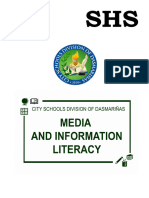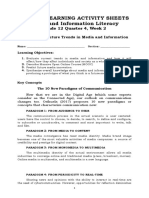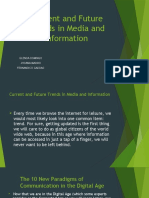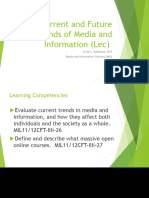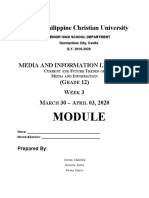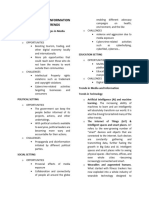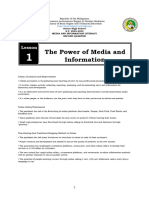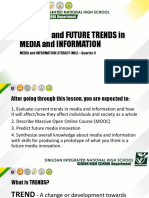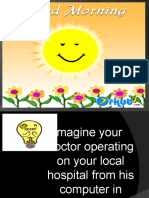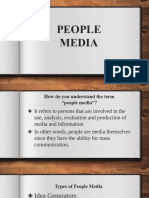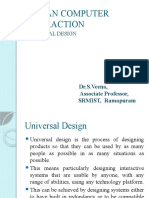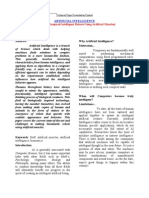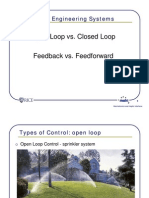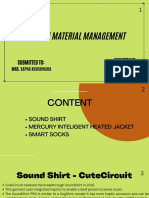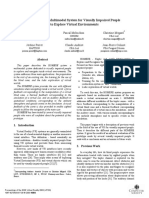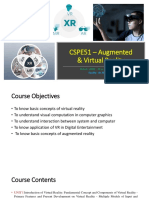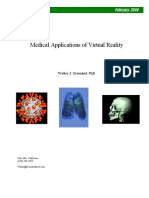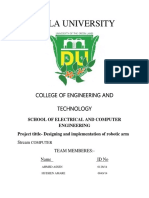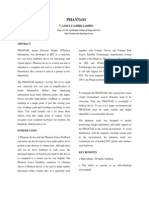LESSON 9:
Current and future trends of Media and Information
Nowadays, people create new things out of their ideas and creative mind knowing that it will be popular and it
will make a trend. Especially in today’s generation, a simple invention will lead to a bigger and popular one thanks to
social media and technology; we can’t stop the trends because it will be widely spread on the internet. According to Ms.
Leizel Avila, here are the current and future trends:
Mobile
36% of the journalists recognize mobile as the important trend of the year.
Digital
Integration of social media in newsroom and reliance on videos and images ranked 2 nd and 3rd among trends.
Native or Indigenous
49% believe native advertising will be the top revenue source for their respective media outlets.
Visual
66% consider page views their most important metric.
Native Advertising
This is a form of online advertising that matches the form and function of the platform on which it appears.
These trends will continue to be a trend & or mainstream depending on the needs and the like of the audiences.
Let us make use of the trends in a helpful way for the benefit of everybody.
Many of the technological advances we are seeing today will shape our daily life in the future – the way we
relax, interact, communicate and conduct business. From virtual worlds, avatar emotions, artificial intelligence,
computer generated storytelling and narrative, interactive 360 holographic images, mixed reality, stress disorder virtual
therapies and so much more. ICT will continue to advance, empower and transform every aspect of our life.
Here are some of these emerging technologies and trends:
Haptics technology -- Is a feedback technology (using computer applications) that takes advantage of the user’s
sense of touch by applying force, vibrations and/or motions to the User.Simple haptics is used in game
controllers, joysticks and steering wheels and is becoming more common in Smartphones. Haptics is gaining
widespread acceptance as a key part of virtual reality systems (i.e. computer simulated environments) - adding
the sense of touch to previously visual only solutions. It is also used in virtual arts, such as sound synthesis,
graphic design and animation. There are many possibilities for Haptics to be applied to gaming, movies,
manufacturing, medical, and other industries. Imagine your doctor operating on your local hospital from his
computer in Australia.
Contextual awareness -- By combining ‘hard sensor’ information such as where you are and the conditions
around you, combined with ‘soft sensors’ such as your calendar, your social network and past preferences -
future devices will constantly learn about who you are and how you live,work and play. As your devices learn
about your life, they can begin to anticipate your needs. Imagine your PC advising you to leave home 15 minutes
early or take a different route to avoid a traffic jam on your way to work. Consider a “context aware” remote
control that instantly determines who is holding it and automatically selects the Smart TV preferences for that
person.
Voice and tone recognition -- Not only can voice and tone recognition be used to confirm a person’s identity but
tone recognition can be used to detect a person’s health or emotional state. This technology will open new
opportunities in security and healthcare – with mobile applications.
Intelligent routing to devices -- This future technology will be useful to, for example, local councils. While on the
move, staff will be able to provide the precise description and location of a street-based issue using
Smartphones and mobile devices that can take photos and have GPS (global positioning system) support.
Intelligent routing will then alert the responsible team to action.
Eye tracking technology -- Eye tracking technology measures eye positions and movements which are analyzed
through computer applications. Future laptops, smartphones and tablets could contain thousands of tiny
imaging sensors built into the display screen. Eye tracking technology could have many possible applications,
including:
o Law enforcement – lie detection
o Airport security – identifying suspicious behavior, e.g. to catch terrorists before they strike
o Retail – recording, monitoring and analyzing consumer behavior to ‘tailor’ marketing to individuals
o Safety - alerting and awakening a drowsy or distracted driver would save many lives
� o Health care – assisting people with disabilities or paralysis to communicate (laptop) and improve mobility
(electric wheelchair)
o Human-computer interaction – using screen icons and a blink here or a gaze there. Say goodbye to the mouse
and keyboard.
Internet glasses! -- Technology that can display images directly onto our retinas while not blocking our sight is
being developed. This technology can be used in eyeglasses and have uses ranging from e-Gaming to military
defense. In the next 10-20 years experts predict that Internet glasses will replace Smartphones. Imagine these
viewing experiences:
a. Seeing building schematics and locations of others (especially useful for security or firefighters)
b. Giving a speech while information is streamed to your eyeglasses in real time
c. Receiving turn by turn directions as you walk toward your destination
d. Viewing virtual recipes while cooking without losing your rhythm
e. Walking down the street, seeing one of your friends show up "on screen" 2 blocks and 1 cafe away
Massive Open Online Content and its Implications:
Massive open online Content (MOOC) is defined by Educause as a model for delivering learning content online to any
person who wants to take a course, with no limit on attendance. It can be characterized by the following:
a. A revolutionary approach to education that veers away from the physical to the virtual.
b. A kind of learning that happens online, breaking the norm of traditional schools or universities for higher
education.
c. Utilizes information technologies like analytics to help instructors gauge their student’s learning.
d. Emphasis on connectedness.
The Implications
By taking learning into virtual space, attendance is no longer a determining factor in one’s education. This makes
MOOC learning a popular alternative for those whose life situations make them unable to attend regular schools, since it
focuses on connectedness as part of the learning process. MOOC allows education to take place on a global scale. MOOC
allows education to take place on a global scale, connecting the learners and instructors all over the world to one
another to maximize education.
MOOC advantage
The paperless society is a society where communication is done electronically and all forms of printed
communication have become obsolete. It is characterized by the shift from letters to e-mails, newspapers to news web
pages, books to e-book, and so on. Ubiquitous learning is common in the age of information. Since information in the
digital age can be accessed by anyone, at any given time and place, ubiquitous or an ever-present type learning of
learning is possible.




















